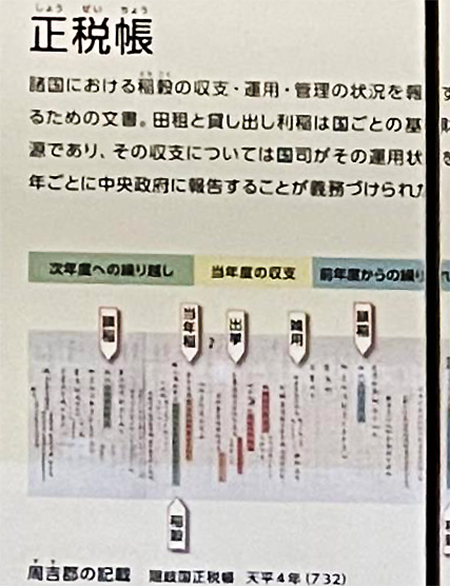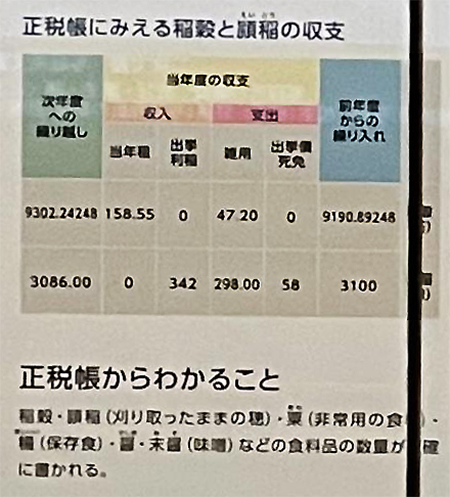

大蔵(財務)省などの官僚制度は最初期の大宝律令体制から1300年以上の歴史。
そもそも国家というのは、水田農耕という社会集団形成・基盤産業革命によって
生み出された剰余価値=「保存可能な食糧など」を管理し
その価値を管理する必要性から「まつりごと」が生成したことは自明だろう。
その基本を構成するのは、日本社会ではコメの管理。
国立歴史民俗博物館でその様子の記録のパネル展示。
図表では一部が展示パネルを保護するガラスの陰影があって
タテにスジが入ってしまったことはご容赦願いたい。
また、読解不分明な箇所もあるけれど、おおむね内容はわかる。
日本という始原期の国家による「正税帳」という
食糧国家管理の様子が克明に記録されている展示です。
この税を納めるために人びとが汗水を流し農作業労働に勤しんだ光景が
強く脳裏に浮かんでくるように感じられる。
Wikipediaで確認すると「官僚制(官制)」には以下の記載。
〜律令制(大宝律令)以前
律令制以前において、体系的な官制は整備されていない。
ヤマト王権形成期においては「姓(カバネ)」と呼ばれる血縁集団から
「氏(ウジ)」と呼ばれる同族集団が現れ、この「氏」や「部」と呼ばれる職能集団が、
それぞれの勢力や能力によって王権内の仕事を分掌した。「氏・部」は
各々、土地と人民を所有・支配した(部民制)。次第に「姓・氏・部」は、
王権によって序列化・統制され、私的な集団から公的な制度へ編成されて行く。
(→氏姓制度、人制、八色の姓)
一方、皇族(大王の一族)を中心の支配体制を強化し、血縁や勢力にとらわれない
人材登用を進めるため、官位(冠位)制度(官職と位階の制度)も取り入れられる。
603年(推古11年)聖徳太子が制定した冠位十二階は、その嚆矢である。
この官位制度は冠位十二階から律令による官位制まで、数度の変遷がある。
氏姓制度と官位制、および職掌を体系的に整備したのが律令制。
668年(天智8年)に最初の「令(りょう)」である近江令が制定され、
689年(持統3年)の飛鳥浄御原令において初めて体系化されたといわれる。
701年(大宝元年)に成立した大宝律令は集大成となった。〜
いかにわたしが歴史の授業をきちんと聞いていなかったかが解明された(笑)。
大蔵省の後継組織によるつい最近の「増税」の声に引きずられ掘り起こした。
ただ、日本人はこういう税制管理体制に対して
正面からそれへの反抗を見せたことは歴史上かつてない、とも言われる。
税を納めることでさまざまな社会の秩序が維持されていること、
その「正統性」に対して異議申し立てはなかったのだ。
聖徳太子によって「和を以て貴しと為す」大方針が示され、歴世、
そのことはおおむね「まつりごと」に反映されてきたといえるのだろうか。
わたしには古代の「民主主義宣言」とも感じられる。
日本で「易姓革命」というものは起こらなかったのが歴史事実。
English version⬇
The Ministry of Finance” government system in the primitive period.
The Ministry of Finance, a “festival” that also used national defense as an excuse to raise taxes, is the original “Ministry of Finance” government system. The national policy of “Harmony is Precious” is something to think about now. The Japanese Government
The bureaucratic system such as the Ministry of Finance (Daizo) has a history of over 1,300 years since the first period of the Taiho Ritsuryo system.
In the first place, the state was created through the formation of social groups based on paddy field agriculture and the industrial revolution.
The state was formed out of the need to manage the value of surplus value (i.e., “storable food, etc.”) generated by the formation of social groups and the basic industrial revolution of rice paddy farming.
It should be obvious that “matsuri” was created out of the need to manage this value.
In Japanese society, the basis for this is the management of rice.
Panel exhibition of records of this situation at the National Museum of Japanese History.
In the chart, part of it is shaded by the glass protecting the display panels.
I hope you will forgive me for the vertical lines in the figures.
Also, although there are some parts that are not clear enough to read, the contents are generally understandable.
The “Shozeicho” or “tax book” of the primitive Japanese state clearly records the state management of foodstuffs.
This exhibit clearly records the state management of foodstuffs by the primitive nation of Japan.
The scene of people working hard to pay this tax through sweat and toil on the farm is very vivid in my mind.
The exhibition is a strong reminder of the scene of people’s toil and hard work to pay the tax.
Wikipedia lists the following for “bureaucracy (kansei)”: ~Ritsuryo system (Taiho Ritsuryo)
〜Before the Ritsuryo system (Taiho Ritsuryo)
Prior to the Ritsuryo system, no systematic government system was established.
In the period of the formation of the Yamato kingdom, the clan system was changed from a blood group called “kabane” to a clan called “uji”.
The “clan” or “division” of the Yamato kingship was formed by the power and ability of each of these clans.
These “clans” and “divisions” divided the work of the royal authority according to their own power and abilities. The “clans and divisions” were
Each clan or division owned and ruled the land and the people (tribal system). Gradually, the “families, clans, and divisions” became hierarchical and controlled by the royal authority.
The “family name, clan, and division” were gradually ranked and controlled by the royal authority, and organized from a private group into a public system (→ clan-surname system, personhood system).
(→ clan and surname system, personhood system, eight-color surname)
On the other hand, in order to strengthen the ruling system centering on the imperial family (the family of the great kings) and to promote the appointment of human resources regardless of blood and power
In order to promote the appointment of human resources, a system of official positions and ranks was introduced.
The 12 ranks of coronation established by Prince Shotoku in 603 (11th year of Suiko) are a pioneering example of this system.
The system of official ranks has undergone several changes from the Crown Twelve Ranks to the Ritsuryo system of official ranks.
The Ritsuryo system system systematically established the clan and family name system, the system of official ranks, and the duties and responsibilities of each position.
In 668, the first “ryo” (decree), the Omi decree, was enacted.
The Asuka Jomihara Order of 689 (Jito 3) is said to have systematized the system for the first time.
The Taiho Ritsuryo Code of 701 (the first year of the Taiho era) was the culmination of this system. ~…
This is a good example of how I have not been listening to my history lessons properly.
The recent calls for “tax hikes” by the successor organization of the Ministry of Finance have made me dig it up.
However, the Japanese people have never shown any outright defiance of this kind of tax management system.
However, it is said that the Japanese have never before in their history shown such a head-on defiance of the tax administration system.
The fact that various social orders are maintained through the payment of taxes, and the fact that the “legitimacy” of the tax system is challenged.
There was no objection to the “legitimacy” of the tax system.
Prince Shotoku set the general policy of “harmony is the noblest”, and this policy was generally reflected in “matsuri goto” throughout the ages.
Has this policy been generally reflected in the “festivals” throughout history?
I feel that this is an ancient “declaration of democracy.
It is a historical fact that the “Easy Family Reformation” did not take place in Japan.
Posted on 12月 24th, 2022 by 三木 奎吾
Filed under: 未分類







コメントを投稿
「※誹謗中傷や、悪意のある書き込み、営利目的などのコメントを防ぐために、投稿された全てのコメントは一時的に保留されますのでご了承ください。」
You must be logged in to post a comment.